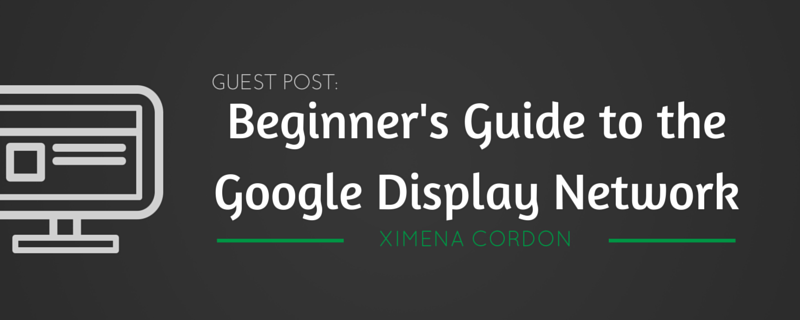BLOG
Guide to the Google Display Network
The Google Display Network is a collection of millions of websites and mobile applications that can show AdWords ads. Its reach is so vast that Google states that the GDN reaches 90% of internet users worldwide. For this reason, and naturally so, most businesses use the GDN to increase their brand awareness and website traffic.
What’s the Difference Between the Google Display Network and Search?
When you run a search campaign, you are trying to satisfy or respond to the user’s search intent. In other words, they are actively looking for your product. Conversely, the GDN is more passive, as the ads displayed there are shown on multiple sites while the user is browsing through. In other words, the user may not be necessarily looking to buy a product or in the need of a service.
The Best Ad Types to Get a Head Start
There are five different ad types available in the GDN. However, the most common ones and the ones I recommend that beginners start off with are text ads, image ads and dynamic ads.
Sneak Your Message in With Text Ads
Texts ads are similar to search ads in terms of their layout, structure and limitation such as limited space. However, they usually accrue more traffic because one ad can fit on many slots of various sizes.

Appeal to your Potential Visitors Visually with Image Ads
These ads allow you to be more visually appealing through the use of imagery. They are not intended to be text heavy, therefore, make sure that you get your message across fast with a short message and that is its attractive or enticing ad.

Use Your Product Feed to Run Dynamic Display Ads
Dynamic Display ads grab data from your Product Feed in the Merchant Center. They are usually easier to set up because putting your visuals together is a fairly easy process since the information in your ads is gathered from your Product Feed.

Pro Tip: For some reason, the ads in the ad preview tool always look better than on the real ad. So don’t be discouraged when you notice this and plan ahead.
How to Target Users on the GDN
There is an array of targeting methods you can use in the GDN, they are:
Match Your Keywords to Relevant Content with Contextual Targeting
Add keywords which are then matched to websites that are part of the GDN. There are no match types with this option, so you can forget about them.
Avoid throwing all keywords under one ad group because it makes it a bit harder to match to appropriate websites. In other words, structure your keywords by adding them to ad groups that have a ‘theme’ in common. You can implement the same strategies that you would use for a regular search campaign.
Handpick Where to Show Your Ads with Managed Placements
A ‘placement’ refers to a website or mobile app where your ad can be displayed. Placements can be automatic which means that your ad will be displayed on certain websites based on your targeting methods.
Placements can also be managed which means that you will manually add the specific sites in which you want your ads to appear. For instance, a travel agency may choose to show their ads on ChepoAir.com
Topics Help You Target People Based on Relevant Themes
A topic is like a theme, and Google offers you a preset list with a variety of them. From this list, you can choose the topics that are related to your business. I recommend this targeting for reaching a big audience quickly.
Target People Based on Their Search History with Interests
With interests, you can target people based on their search history. Therefore, your ads will most likely appear on a website that may have nothing to do with your brand. However, these are websites that your potential customer visits frequently, so it can be good for branding for them to see your brand as they browse the web. The other side of the coin is that you could be perceived as stalkerish.
Bring Your Visitors Back with Remarketing
Remarketing is awesome because it allows you to show your ads to users that have previously visited your site. Thus, it is a great opportunity to close a sale or to stay relevant in your potential client’s mind.
Pro tip: Remarketing works great when combined with a search/shopping campaign to get a second chance at closing sales. I also recommend that you include a promotion on your ads like: “ Get 10% Off your First Purchase.”
My Recommended GDN Targeting Formula
To get started, I recommend you combine keywords and topics. This will allow you to attract quickly the right audience by allowing your website to appear next to content that completely matches the intent of your business.
In terms of usability, I think this is the best way to transition from only running search campaigns since contextual targeting and topics can be set up similarly from a search campaign.
Furthermore, running a campaign with these two targeting methods will allow you to test if the GDN is the right approach for you without much effort. Use a small amount of ad groups with not too many keywords and a few carefully picked topics to start this test.

What Type of Bidding Should I Use?
On campaigns on the Display Network, you can choose to use a CPC (cost-per-click strategy) or a CPM (cost per thousand impressions) bid strategies.
The type of bidding you should use is highly dependent on the type of goals you have with your Display campaign. Do know that having a CPC strategy tends to drive better quality of impressions, thus clicks. On the other hand, a CPM strategy will often drive a larger amount of impressions but not focus on quality.
Widen Your Reach with the Google Display Network
The Google Display Network is a great way to widen the reach of your existing online marketing efforts. Using it will give you access to tap your users and find them or nurture them as they browse the web.
It’s important that you remember that you should always consider running a Display campaign along with a Search one, especially if you are already running a successful search campaign. If you do this, you will be able to reach the audience that is actively searching for your product or services along with the ones that are passively searching.
ABOUT THE AUTHOR 
Ximena leads White Shark Media‘s Content Marketing efforts by coordinating, developing and improving content from across White Shark Media’s departments.











